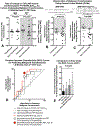Rate of change in maximum 18F-FDOPA PET uptake and non-enhancing tumor volume predict malignant transformation and overall survival in low-grade gliomas
- PMID: 31981013
- PMCID: PMC7080591
- DOI: 10.1007/s11060-020-03407-w
Rate of change in maximum 18F-FDOPA PET uptake and non-enhancing tumor volume predict malignant transformation and overall survival in low-grade gliomas
Abstract
Purpose: To examine whether the rate of change in maximum 18F-FDOPA PET uptake and the rate of change in non-enhancing tumor volume could predict malignant transformation and residual overall survival (OS) in low grade glioma (LGG) patients who received serial 18F-FDOPA PET and MRI scans.
Methods: 27 LGG patients with ≥ 2 18F-FDOPA PET and MRI scans between 2003 and 2016 were included. The rate of change in FLAIR volume (uL/day) and maximum normalized 18F-FDOPA specific uptake value (nSUVmax/month), were compared between histological and molecular subtypes. General linear models (GLMs) were used to integrate clinical information with MR-PET measurements to predict malignant transformation. Cox univariate and multivariable regression analyses were performed to identify imaging and clinical risk factors related to OS.
Results: A GLM using patient age, treatment, the rate of change in FLAIR and 18F-FDOPA nSUVmax could predict malignant transformation with > 67% sensitivity and specificity (AUC = 0.7556, P = 0.0248). A significant association was observed between OS and continuous rates of change in PET uptake (HR = 1.0212, P = 0.0034). Cox multivariable analysis confirmed that continuous measures of the rate of change in PET uptake was an independent predictor of OS (HR = 1.0242, P = 0.0033); however, stratification of patients based on increasing or decreasing rate of change in FLAIR (HR = 2.220, P = 0.025), PET uptake (HR = 2.148, P = 0.0311), or both FLAIR and PET (HR = 2.354, P = 0.0135) predicted OS.
Conclusions: The change in maximum normalized 18F-FDOPA PET uptake, with or without clinical information and rate of change in tumor volume, may be useful for predicting the risk of malignant transformation and estimating residual survival in patients with LGG.
Keywords: 18F-FDOPA PET; Biomarker; Low grade glioma; MRI.
Conflict of interest statement
Conflicts of Interest:
Timothy F. Cloughesy reports advisory roles with Roche, Trizel, Medscape, Bayer, Amgen, Odonate Therapeutics, Pascal Biosciences, Bayer, Del Mar Pharmaceuticals, Tocagen, Karyopharm, GW Pharma, Kiyatec, Abbvie, Boehinger Ingelheim, VBI, Deciphera, VBL, Agios, Merck, Roche, Genocea, Celgene, Puma, Lilly, BMS, Cortice, Wellcome Trust, Novocure, Novogen, Boston Biomedical, Sunovion, Human Longevity, Insys, ProNai, Pfizer, Notable labs, Medqia. Stock options with Notable Labs. Member of the board for the 501c3 Global Coalition for Adaptive Research. U.S. Provisional Application No.: 62/819,322 Title: COMPOSITIONS AND METHODS FOR TREATING CANCER.
Benjamin M. Ellingson reports advisory and consulting roles with MedQIA, Roche, Agios, Siemens, Medicenna, Imaging Endpoints, Novogen, Northwest Biopharmaceuticals, Image Analysis Groupm Concoceutics, BeiGene, VBL, and Tocagen. Dr. Ellingson also has research grants with Siemens, Roche, and Janssen.
All other authors declare no conflicts of interest related to the subject matter in this publication.
Figures




Similar articles
-
Maximum Uptake and Hypermetabolic Volume of 18F-FDOPA PET Estimate Molecular Status and Overall Survival in Low-Grade Gliomas: A PET and MRI Study.Clin Nucl Med. 2020 Dec;45(12):e505-e511. doi: 10.1097/RLU.0000000000003318. Clin Nucl Med. 2020. PMID: 33031233 Free PMC article.
-
18F-FDOPA PET and MRI characteristics correlate with degree of malignancy and predict survival in treatment-naïve gliomas: a cross-sectional study.J Neurooncol. 2018 Sep;139(2):399-409. doi: 10.1007/s11060-018-2877-6. Epub 2018 Apr 20. J Neurooncol. 2018. PMID: 29679199 Free PMC article.
-
Correlation of 6-18F-fluoro-L-dopa PET uptake with proliferation and tumor grade in newly diagnosed and recurrent gliomas.J Nucl Med. 2010 Oct;51(10):1532-8. doi: 10.2967/jnumed.110.078592. Epub 2010 Sep 16. J Nucl Med. 2010. PMID: 20847166
-
Diagnostic and grading accuracy of 18F-FDOPA PET and PET/CT in patients with gliomas: a systematic review and meta-analysis.BMC Cancer. 2019 Aug 5;19(1):767. doi: 10.1186/s12885-019-5938-0. BMC Cancer. 2019. PMID: 31382920 Free PMC article.
-
Increasing feasibility and utility of (18)F-FDOPA PET for the management of glioma.Nucl Med Biol. 2015 Oct;42(10):788-95. doi: 10.1016/j.nucmedbio.2015.06.001. Epub 2015 Jun 9. Nucl Med Biol. 2015. PMID: 26162582 Review.
Cited by
-
Preferential tumor localization in relation to 18F-FDOPA uptake for lower-grade gliomas.J Neurooncol. 2021 May;152(3):573-582. doi: 10.1007/s11060-021-03730-w. Epub 2021 Mar 11. J Neurooncol. 2021. PMID: 33704629 Free PMC article.
-
Maximum 11C-methionine PET uptake as a prognostic imaging biomarker for newly diagnosed and untreated astrocytic glioma.Sci Rep. 2022 Jan 11;12(1):546. doi: 10.1038/s41598-021-04216-5. Sci Rep. 2022. PMID: 35017570 Free PMC article.
-
Voxelwise and Patientwise Correlation of 18F-FDOPA PET, Relative Cerebral Blood Volume, and Apparent Diffusion Coefficient in Treatment-Naïve Diffuse Gliomas with Different Molecular Subtypes.J Nucl Med. 2021 Mar;62(3):319-325. doi: 10.2967/jnumed.120.247411. Epub 2020 Jul 9. J Nucl Med. 2021. PMID: 32646876 Free PMC article.
-
Maximum Uptake and Hypermetabolic Volume of 18F-FDOPA PET Estimate Molecular Status and Overall Survival in Low-Grade Gliomas: A PET and MRI Study.Clin Nucl Med. 2020 Dec;45(12):e505-e511. doi: 10.1097/RLU.0000000000003318. Clin Nucl Med. 2020. PMID: 33031233 Free PMC article.
-
Multiparametric MR-PET measurements in hypermetabolic regions reflect differences in molecular status and tumor grade in treatment-naïve diffuse gliomas.J Neurooncol. 2020 Sep;149(2):337-346. doi: 10.1007/s11060-020-03613-6. Epub 2020 Sep 14. J Neurooncol. 2020. PMID: 32929644 Free PMC article.
References
-
- Shaw EG, Wang M, Coons SW, Brachman DG, Buckner JC, Stelzer KJ, Barger GR, Brown PD, Gilbert MR, Mehta MP (2012) Randomized trial of radiation therapy plus procarbazine, lomustine, and vincristine chemotherapy for supratentorial adult low-grade glioma: initial results of RTOG 9802. J Clin Oncol 30: 3065–3070 doi:10.1200/JCO.2011.35.8598 - DOI - PMC - PubMed
-
- Buckner JC, Shaw EG, Pugh SL, Chakravarti A, Gilbert MR, Barger GR, Coons S, Ricci P, Bullard D, Brown PD, Stelzer K, Brachman D, Suh JH, Schultz CJ, Bahary JP, Fisher BJ, Kim H, Murtha AD, Bell EH, Won M, Mehta MP, Curran WJ Jr. (2016) Radiation plus Procarbazine, CCNU, and Vincristine in Low-Grade Glioma. N Engl J Med 374: 1344–1355 doi:10.1056/NEJMoa1500925 - DOI - PMC - PubMed

